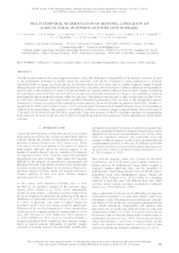Multitemporal segmentation of Sentinel-2 images in an agricultural intensification region in Brazil.
Multitemporal segmentation of Sentinel-2 images in an agricultural intensification region in Brazil.
Author(s): SANTOS, L. T. dos; WERNER, J. P. S.; REIS, A. A. dos; TORO, A. P. G.; ANTUNES, J. F. G.; COUTINHO, A. C.; LAMPARELLI, R. A. C.; MAGALHÃES, P. S. G.; ESQUERDO, J. C. D. M.; FIGUEIREDO, G. K. D. A.
Summary: ABSTRACT: With the recent evolution in the sensor's spatial resolution, such as the MultiSpectral Imager (MSI) of the Sentinel-2 mission, the need to use segmentation techniques in satellite images has increased. Although the advantages of image segmentation to delineate agricultural fields in images are already known, the literature shows that it is rarely used to consider temporal changes in highly managed regions with the intensification of agricultural activities. Therefore, this work aimed to evaluate a multitemporal segmentation method based on the coefficient of variation of spectral bands and vegetation indices obtained from Sentinel-2 images, considering two agricultural years (2018-2019 and 2019-2020) in an area with agricultural intensification. Images of the coefficient of variation represented the spectro-temporal dynamics within the study area. These images were also used to apply an edge detection filter (Sobel) to verify their performance. The region-based algorithm Watershed Segmentation (WS) was used in the segmentation process. Subsequently, to assess the quality of the segmentation results produced, the metrics Potential Segmentation Error (PSE), Number-of-Segments Ratio (NSR), and Euclidean Distance 2 (ED2) were calculated from manually delineated reference objects. The segmentation achieved its best performance when applied to the unfiltered coefficient of variation images of spectral bands with an ED2 equal to 7.289 and 2.529 for 2018-2019 and 2019-2020, respectively. There was a tendency for the WS algorithm to produce over-segmentation in the study area; however, its use proved to be effective in identifying objects in a dynamic area with the intensification of agricultural activities.
Publication year: 2022
Types of publication: Journal article
Observation
Some of Embrapa's publications are published as ePub files. To read them, use or download one of the following free software options to your computer or mobile device. Android: Google Play Books; IOS: iBooks; Windows and Linux: Calibre.
Access other publications
Access the Agricultural Research Database (BDPA) to consult Embrapa's full library collection and records.
Visit Embrapa Bookstore to purchase books and other publications sold by Embrapa.

